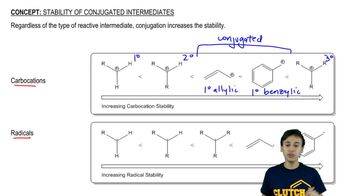Would you expect the following nucleophiles to do 1,2- or 1,4-addition?
(a)
(b)
(c) HO–
 Verified step by step guidance
Verified step by step guidance Verified video answer for a similar problem:
Verified video answer for a similar problem:



 12:6m
12:6mMaster Conjugated Hydrohalogenation - General Mechanism with a bite sized video explanation from Johnny
Start learning